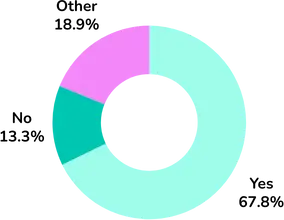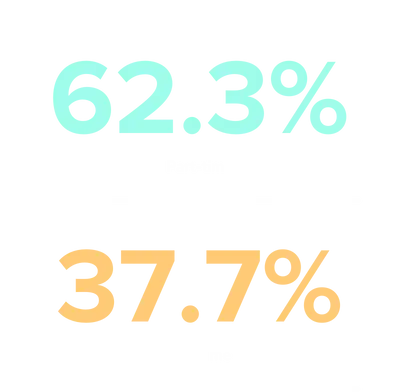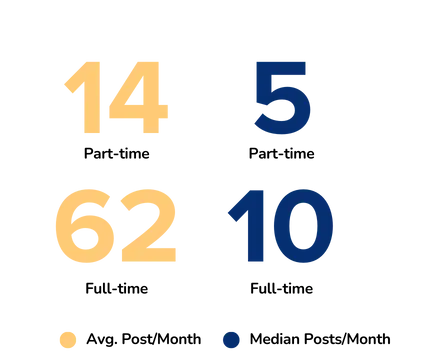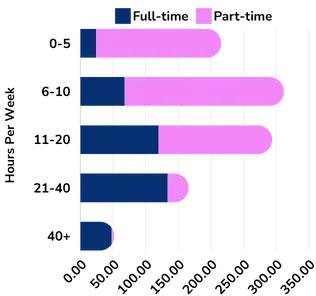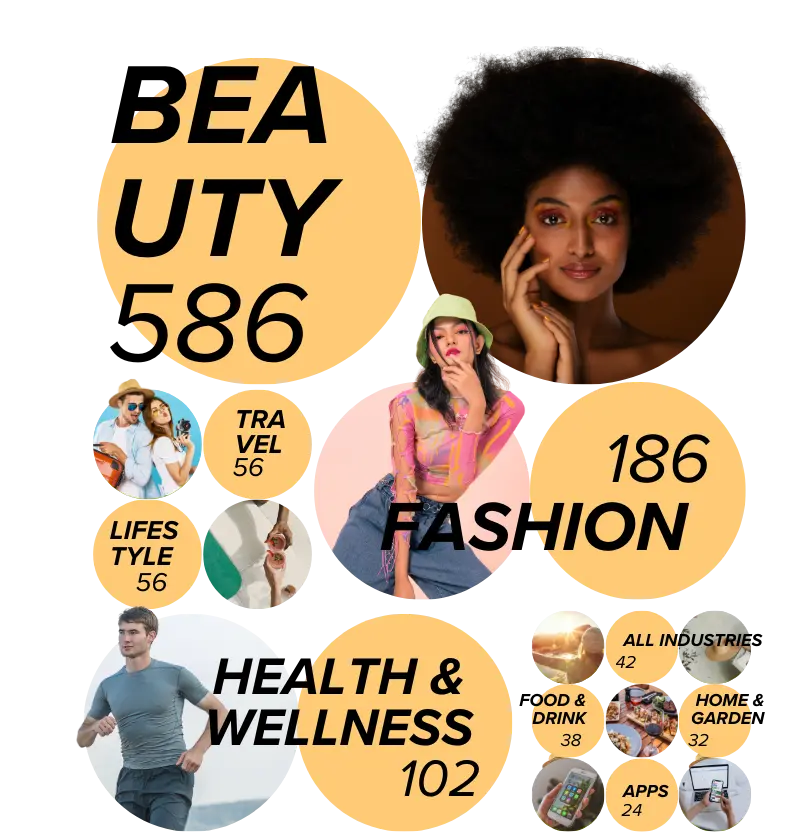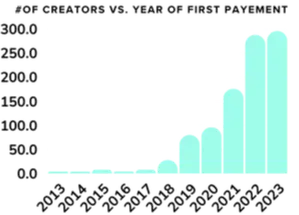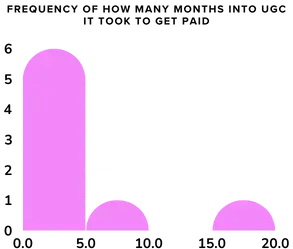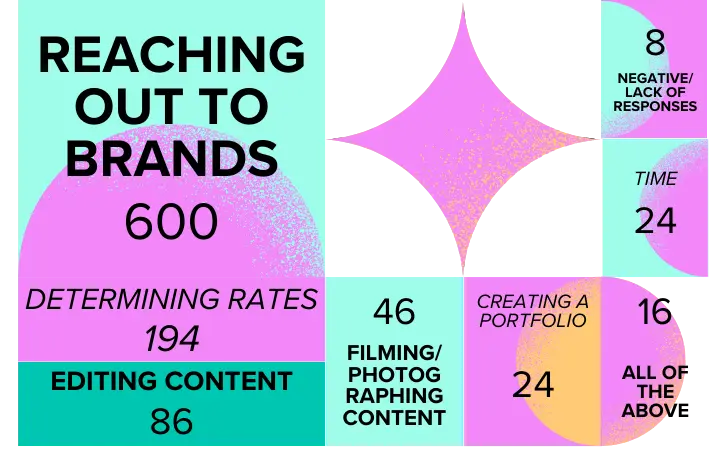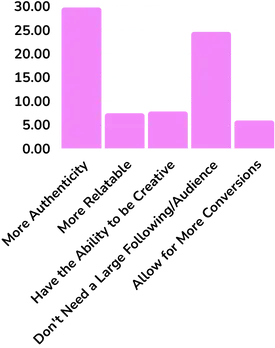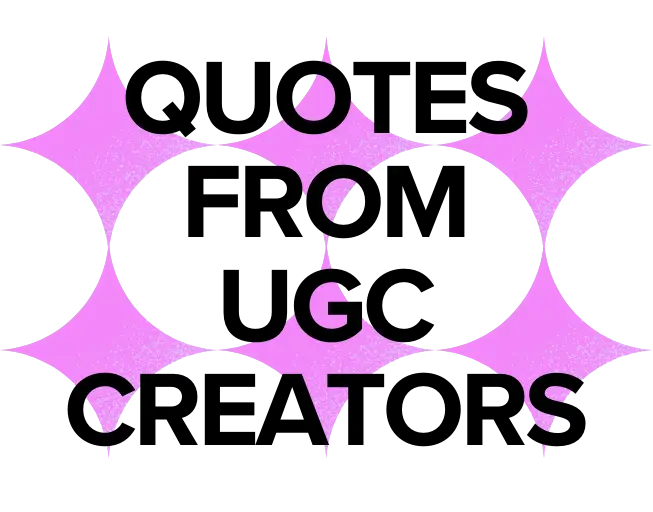In recent years, the landscape of content creation has witnessed a shift with the introduction of User-Generated Content (UGC). Social media platforms have become hubs of creativity, enabling individuals to make and share their own content, on their own terms. UGC creators have flipped the script on the traditional influencer and have shown that it is possible to have a lucrative career making content without a big following.
UGC is definitely on the rise, with 56% of brands focusing on UGC as found in our State of Marketing Report 2024.
This report delves into the world of UGC and UGC creators, shedding light on the people who do UGC, how their careers work, the financial gains they derive from their content, and the sentiments they harbor towards the UGC phenomenon. By exploring these factors, we aim to provide a comprehensive understanding of this transformative force in the digital realm.
DOWNLOAD THE FULL REPORT ON THE RISE OF UGC
The Rise Of UGC:
History of UGC
In recent years, with the rise of social media, UGC has become even more popular with brands as a way to get authentic advertising at a bargain. Brands have been using UGC on their own social media or in their advertising campaigns for many years, but only recently did UGC become a viable and lucrative career option for creators.
As smartphones become more popular and advanced, people at home are able to create quality content for a much lower cost, appealing to brands.
Methodology
The data shown in this report was gathered through a survey conducted in late 2023. We surveyed over 1,000 UGC creators, asking them questions about their following on social media, estimated revenue, and more. To find these creators we used NeoReach’s internal tools to find UGC creators on Instagram and TikTok of all sizes.
To understand the industry, we asked creators what industries they tend to work with, and how much money they estimate they have made from UGC. We also wanted to know what a work week looks like for UGC creators, and how many actually make user-generated content full-time. In addition to the statistics we asked for, we asked creators to tell us their opinions on the future of UGC and how their experience working in UGC has been.
UGC Analysis
In this report, we will look at who UGC creators are and how being a UGC creator works. Diving into the revenue, hours, and social media, this report will give a clear understanding of UGC in today’s world. It will also give a glimpse into the opinions of UGC and what the future could bring.
Audience Demographics
For this report, 96% of the creators we surveyed were female, while 4% were male, showing how women heavily dominate the UGC space.
We also see that most respondents were between the ages of 25-34, making up nearly 51% of the creators. The second most popular age group was 18-24, taking up 37%. There are only less than 11% of respondents above the age of 35, showing that for now, UGC is a younger woman’s game.
Social Media
Understanding social media and how it is used is key to understanding UGC creators. Not only do they publish their own content, but they are used to learn more about the business.
In this section, we will explore each platforms’ most popular UGC creators. We will also look into follower counts and how creators used social media before starting UGC.
Top Social Media Platforms for UGC Creators: TikTok and Instagram Lead the Way
We can see that TikTok is the most popular social media platform for UGC creators, with 54% of creators using it as their primary social media for UGC content. After that, Instagram is the primary social media for more than 42% of respondents. More than 67% of creators also said they post UGC on their own personal accounts, while 13% said they do not.
Followers on Each Social Media
We can see how many surveyed creators use the big four social media platforms – Instagram, TikTok, Twitter, and YouTube. Almost 100% of creators use Instagram in some way, showing that it is clearly the most popular platform in general, even if it's not the first choice for UGC. TikTok is used by almost 97% of creators, making it a close second. Twitter and YouTube are less popular with less than 50% of creators posting on these platforms.
Social Media Before UGC
With this chart, we see which social media platforms creators were making content for before starting UGC. 67% of creators made content on Instagram before UGC, making it the most common choice. More than 8% of creators blogged before starting UGC, being more popular than platforms like Twitter and Twitch. Facebook was also a popular choice with 21% of creators using it to post content before starting UGC. Only 4% of creators said that they did not make any social media content before diving into UGC.
Which Platforms Drive Creators into UGC
When asked what got creators into UGC, we noticed that many creators were influenced by other UGC creators on social media.
We saw that 36.33% of creators mentioned TikTok as a reason they started doing UGC, 20.84% mentioned Instagram. The least commonly mentioned was YouTube, with only 4.4% of creators mentioning it in how they were inspired to begin UGC.
Working in UGC
Working in UGC has become a new trend for savvy creators who want to use their skills in creating content to make a living. As UGC is a rather new business for creators, many are left figuring it out for themselves and determining their own working hours and who they work for. We will look at what it is like for creators working in UGC. This includes how long creators have been doing it, and whether or not they consider themselves full or part-time creators. We will also look at the industries and number of brands creators tend to work with.
How Long Creators Have Worked in UGC
Our survey highlights the infancy of the UGC industry, with 59% of creators doing UGC for less than 1 year. 21% of creators have been in UGC for 1-2 years, while 12.4% have been for 2-3 years. Only 4% of creators have done UGC for more than 4 years.
Industry Growth
User-generated content (UGC) has been an option for several years, but recently, it's seen a swift upswing in popularity. This surge has led to a 145% rise in the number of UGC creators over the last year.
Posts Per Month
With this chart, we can see how often creators post and how long they have worked in UGC. While creators that have been in UGC for 1-2 years average the most posts per month, with an average of 71, it is creators that have been doing UGC for 3-4 years that have the highest median, with almost 12 posts per month. Creators in UGC for more than 4 years seem to post the least amount of content on a monthly basis.
Here we can see that full-time UGC creators post significantly more often than part-time workers, on average. However, when looking at the median number of posts per month, we can see it is actually a lot closer, with a median of 10 posts per month for full-time and 5 posts per month for part-time.
We can see most creators work 6-10 hours per week, especially part-time creators. Most full-time creators work 21-40 hours per week, followed by 11-20 hours.
Full Time vs Part Time Creators
Here we can see that almost two thirds of creators consider themselves part-time creators. This usually means that UGC is not their main or only source of income. With UGC being a new, and rather saturated market, it makes sense that many creators are not able or willing to do it full-time yet.
Posts Per Month for Full-time vs. Part-time
Here we can see that full-time UGC creators post significantly more often than part-time workers, on average. However, when looking at the median number of posts per month, we can see it is actually a lot closer, with a median of 10 posts per month for full-time and 5 posts per month for part-time.
Hours Per Week For Full/Part Time Creators
We can see most creators work 6-10 hours per week, especially part-time creators. Most full-time creators work 21-40 hours per week, followed by 11-20 hours.
How Many Brands Creators Worked With
We also asked creators how many brands they have worked with during their UGC career. We saw that 67% of creators have worked with more than 6+ brands. This shows that creators are trying to have a diverse portfolio, or that brands do not often work with the same creators. Only 107 of the sampled creators have worked with only 1 brand, representing 10.3% of the sample.
How Many Creators Have Worked With Each Industry
We asked creators for the primary industries that they make content for, and here we can see the top 10 industries that were mentioned. With almost 300 creators mentioning Beauty, we can infer that it is the most popular industry in the UGC space right now. Being mentioned by almost 100 creators, Fashion is the next most popular industry. 21 creators responded that they work with a mix of all industries, and do not have one that takes precedence.
Revenue & Compensation
With UGC being relatively new, it is also important to understand how much UGC creators are earning from their work. This information can be used by creators and brands as a guide for the industry standard and if UGC is right for them.
Total Earnings & Average Annual Earnings
We asked creators to tell us their estimated earnings from UGC to date, as well as their estimated annual earnings. While the average estimated total earnings was $12.3k, the median total earnings was $1,000. That means most creators have made around that much, with only a few creators making much more. In total, the creators we surveyed have earned an estimated $5.7M from UGC.
We can also see that the median annual earnings were $1,500. For many creators that have not been doing UGC for a full year, this could be their predicted earnings for the year. It could also come from the more experienced creators and their estimated earnings from the past year.
When Creators First Got Paid For UGC
In this chart, we can see most UGC creators first received payment for their UGC work in 2022, followed closely by 2023 to date. Almost 60% of creators first got paid in the last two years, once again showing how new UGC is.
Here we can see how long it took for creators to get paid for the first time after starting UGC. It took most creators less than one year to get paid for their content, rather than being gifted products. It can be a while until creators get paid for their content if they have to build their portfolio and relationships with brands.
Gifted Compensation
Many UGC creators are compensated with gifted products instead of a monetary payment. For brands, this can be a much more cost-effective way to get user-generated content. For creators just getting started, this is a way to get into the business and accumulate more products and content for their portfolio.
Throughout this report, we noted the creators that had mentioned only receiving gifted products as compensation. We found that the follower count of these creators, averaged 6.1K for TikTok and 5.2K for Instagram.
We also found that more than 76% of the creators that have only received gifts from brands have been working in UGC for less than a year. Meanwhile, only 2.4% have been in UGC for more than 4 years. While some creators may prefer this to standard payment, most creators accept gifted compensation only at the beginning of their careers.
What Creators Think of UGC
As a part of the survey, we also asked creators their opinions on UGC and how they feel about working in UGC. As UGC is a new business, it is important to hear from creators directly, as they are likely the most knowledgeable. In this report, we look at how creators answered questions about the hardest and best parts of UGC, how UGC creators differ from other creators, and more.
Hardest Part of Being a UGC Creator
When asked what the hardest part of being a UGC creator was, 57% of creators mentioned reaching out to brands and 18% said determining rates. We can see with this data that creators clearly have the most trouble with the business aspect of UGC, rather than the content.
Best Part of Being a UGC Creator
We also asked creators their favorite parts of being a UGC Creator. 32% of creators said they enjoyed making the content the most, while 24% of creators mentioned not needing a big social following and being able to be independent.
Why Brands Use UGC
In the survey, we asked creators why they think brands use UGC over influencers or other traditional marketing strategies. 66% of creators said that brands choose them to increase their brand authenticity. UGC is often thought of as more authentic as it comes from regular people instead of celebrities or big influencers.
13% of respondents said they believe UGC is chosen due to the lower cost and the higher conversion rates that UGC offers, while 4% said that UGC can reach a younger audience.
How UGC Creators Differ from Other Creators
We asked creators how they think UGC creators differ from other creators on the internet. Once again, most UGC creators mentioned how there is more trust and authenticity from UGC creators than influencers. Another popular response was that UGC creators do not need a large following to be successful, which is vital to influencers in order to get sponsorships and other opportunities. 7.8% of creators we surveyed also mentioned that UGC creators have more of an opportunity to be creative in their work than influencers. Influencers often have a more strict set of guidelines for their sponsored content from the brand, while UGC creators can have more free reign over their content.
The Future of UGC
When asked their opinion on the future of UGC, 60% of creators said that they believe UGC will continue to grow. Some creators also mentioned that the industry will become oversaturated and that creators will need to be very skilled to be successful.
Quotes From Creators
Let's hear it from the creators themselves. We asked creators what their understanding of UGC creators is, the best part of being a creator, their struggles, goals, and what they think the future of the creator economy is. Here’s some of their thoughts.
Quote #1
The phrase "If you want to get paid like a business, you have to treat it like a business" has never made more sense than it does now being a UGC creator.
More often than not people in your immediate circle can make you feel like its "just some little thing you do" and in turn I think many people let that hold them back instead of being cringe and going for it.
Quote #2
Since becoming a UGC Creator, I have learned so much about working with brands, negotiation and most importantly, knowing my worth.
When you start out in the industry there are lots of brands that are going to try to knock you down, and you have to stand firm in your value.
Quote #3
Many brands are willing to do free product collaborations right away and will pay you if you counter and ask if they have a budget.
If they don't, often times they are willing to give more product to make it more worth your time.
Quote #4
I think more people are going to lean more into becoming UGC creators to have that freedom with time.
I also think brands will start gearing more toward UGC instead of paying big companies and celebrities for commercials to reach a newer audience.
Quote #5
I believe we are only scratching the surface of UGC and brands will start to understand its value more as it grows.
Not all brands have adopted the concept or understand the value of UGC. A lot of brands still think of us as "sales people" and base us off of conversion. I will continue to strive to be a UGC Creator alongside my normal content creation.
Quote #6
I think personal branding will be more important than ever! This will make one UGC creator different from another!
Growing your personal brand will be as important to clients in the future! The more you appear on socials the quicker you’ll get hired with your rates!
UGC vs Traditional
While both make content for brands, there are key differences between UGC and Traditional creators. UGC creators make content, to be posted and owned by brands, that appears authentic and relatable. Meanwhile, influencers, or traditional creators, tend to post sponsored content to their own large, dedicated audience.
UGC Marketing
User-generated content (UGC) creators are paid by brands to create social media content to be posted to brands' accounts, or used in any way brands see fit. This content does not necessarily have to be posted on the creators' social media, and the creator does not need to have any social following to be involved in UGC. When a creator makes UGC for a brand, those photos or videos are owned by the company and can be used without crediting the creator.
While UGC is often considered to be more authentic than traditional influencer marketing, it is also the cheaper option for brands. For now, UGC seems a much less lucrative career choice than being an influencer, with UGC creators making significantly less than influencers from sponsored content.
Traditional Influencer Marketing
When a brand sponsors an influencer, they are paid to post photos or videos to their own social media channels. Influencers continue to own their sponsored content and brands do not always post it to their own channels. Brands can choose which influencers they sponsor based on the size and demographics of their audience and who they are trying to reach.
As influencers have grown in popularity, audiences have less trust in them and their sponsored content. Traditional influencer marketing can also become a very pricey option depending on the influencer. Since the industry has now been around for many years, influencers have become more comfortable asking for more money, provided they have the needed audience.
Comparison
The biggest comparison between UGC creators and influencers is the ownership and purpose of their branded content. UGC creators enter a partnership with a brand and will create photos and videos that will be owned by the company for their own use. This content can be used in traditional advertisements or on the brand’s social media accounts and doesn’t necessarily have to appear on the creator’s accounts.
When an influencer enters a partnership with a brand, the sponsored content will appear on the influencer’s accounts and will be owned by the influencer. These influencers are often chosen for their audience size or demographics.
Another important factor in the choice between an influencer and a UGC creator is what the brand is trying to achieve with this content. If the brand wants to increase awareness, an influencer is a much better choice as they will expose the brand to their audience. However, if a brand wants to increase conversions within its existing audience, it could choose to use UGC for an authentic advertisement.
There is also a big difference between the price for UGC and an influencer paid advertisement. As UGC is a newer concept, many creators have lower rates and are more likely to accept gifted compensation. Most influencers have higher rates and are able to charge more if they have a larger audience or higher engagement.
Key Takeaways
From this report, we can gather many conclusions about the current state of UGC. We can see that the majority of UGC appears on Instagram and TikTok and tends to be made for Beauty brands. UGC is a relatively new business, with most creators doing it for less than one year and are only part-time. For creators, UGC has not become as profitable as other revenue sources, with the median annual income being only $1,500.
When asked, UGC creators tended to say they enjoy creating the content and the independence UGC allows, while they struggle with talking to brands and determining their rates. The consensus of creators was that UGC and its creators have more authenticity compared to traditional advertisements and influencer marketing, making it a business that is going to continue to grow.
Future Predictions
Based on the data in this report, we can make a few predictions on how the UGC industry will continue through 2024. From all of the new creators entering the UGC industry in the last year, we can expect this to continue throughout 2024. With this, however, we can also expect the space to become very saturated making it harder for all creators to find work.
As creators get more experience in UGC, we can expect rates to increase, but not to the place of influencer sponsorships. UGC will remain a cheaper option for brands, one which they will likely continue to take advantage of more and more. We do not expect brands to completely replace influencer paid ads with UGC, but they will instead use them for different applications. UGC will be used when brands need authentic advertisements meant to improve conversions, while they will continue influencer sponsorships to raise awareness.
Editor’s Note
In the past few years, User-generated content has grown exponentially, and with it the ability for people to make a career out of creating content without having a big audience. In this report, we investigated the UGC space and its creators, in order to give clarity for brands and other creators. We looked at how creators feel about the current and future state of the UGC industry, and how they think UGC compares to traditional influencer advertising. We also looked at who is taking part in UGC and what the career looks like right now.
With all the data shown in this report, brands and creators can make more informed decisions about UGC and whether they want to utilize it for themselves. While it is a cheaper, more authentic marketing choice for brands, it is also another revenue source and creative outlet for creators.
Let Us Run Your Next Campaign!
Ready to launch your most lucrative influencer marketing campaign ever? Are you prepared to go viral with the biggest powerhouse influencers on social media? Let NeoReach and our talented team of experts bring your campaign to life!




